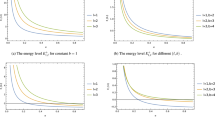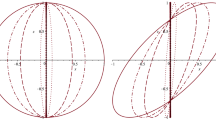Abstract
Breaking a Yang–Mills symmetry at very high energy could lead to macroscopic structures in the vacuum called ‘strings’, which may be the cause of galaxy formation and clustering. Dissipative gravitational interactions of string loops can produce unusual astrophysical side effects. Such scenarios generally predict a stochastic background of gravitational radiation which should be observable using the millisecond pulsar 1937 + 21. Gravitational radiation recoil accelerates loops, but dynamical friction on ordinary matter tends to slow them down so they may be able to accrete matter. Internal oscillations of loops produce a time-varying shear perturbation which may lead to an observable heating of stellar or gaseous systems in their immediate neighbourhood.
This is a preview of subscription content, access via your institution
Access options
Subscribe to this journal
Receive 51 print issues and online access
$199.00 per year
only $3.90 per issue
Buy this article
- Purchase on Springer Link
- Instant access to full article PDF
Prices may be subject to local taxes which are calculated during checkout
Similar content being viewed by others
References
Kibble, T. W. B. J. Phys. A 9, 1387–1398 (1976); Phys. Rep. 67, 183–199 (1983).
Preskill, J. The Very Early Universe (eds Gibbons, G. W., Hawking, S. W. & Siklos, S. T. C.) pp. 119–146 (Cambridge University Press, 1983).
Zeldovich, Ya. B. Mon. Not. R. astr. Soc. 192, 663–667 (1980).
Vilenkin, A. Phys. Rev. Lett. 46, 1169–1172 (1981); Phys. Rev. D 24, 2082–2089 (1981).
Turok, N. Grand Unified Strings and Galaxy Formation. Preprint (Univ. California, Santa Barbara, UCSB TH-3, 1984).
Vilenkin, A. Phys. Lett. 107 B, 47–50 (1982).
Wilczek, F. The U(1) Problem: Instantons, Axions and Familons, Preprint (ITP-84-14, Santa Barbara, 1984).
Kibble, T. W. B. & Turok, N. Phys. Lett. 116 B, 141–146 (1982).
Fall, S. M. Rev. mod. Phys. 51, 21–42 (1979).
Gibbons, G. W., Hawking, S. W. & Siklos, S. T. C. (eds) The Very Early Universe (Cambridge University Press, 1983).
Starobinsky, A. JETP Lett. 30, 682–685 (1979).
Rubakov, V., Sazhin, M. & Veryaskin, A. Phys. Lett. 115 B, 189–192 (1982).
Detweiler, S. Astrophys. J. 234, 1100–1104 (1979).
Bertotti, B., Carr, B. J. & Rees, M. J. Mon. Not. R. astr. Soc. 203, 945–954 (1983).
Rees, M. J. in Gravitational Radiation (eds Deruelle, N. & Piran, T., 297 (North-Holland, Amsterdam, 1983).
Cordes, J. M. & Stinebring, D. R. Astrophys. J. Lett. 277, L53–L56 (1984).
Backer, D. C. J. Astrophys. Astr. (1984).
Armstrong, J. W. Nature 307, 527–528 (1984).
Hogan, C. Phys. Lett. (in the press).
Silk, J. & Vilenkin, A. Cosmic Strings and Galaxy Formation, Preprint (Univ. California, Berkeley, 1984).
Kaiser, N. & Stebbins, A. Nature 310, 391–393 (1984).
Rephaeli, Y. & Salpeter, E. E. Astrophys. J. 240, 20–24 (1980).
Blandford, R., Narayan, R. & Romani, R. W. J. Astrophys. Astr. (in the press).
Goddard, P., Goldstone, J., Rebbi, C. & Thorn, C. B. Nuclear Phys. B56, 109–135 (1973).
Turock, N. Phys. Lett. 126B, 437–440 (1983).
Blumenthal, G. R., Faber, S. M., Primack, J. R. & Rees, M. J. Nature (in the press).
Author information
Authors and Affiliations
Rights and permissions
About this article
Cite this article
Hogan, C., Rees, M. Gravitational interactions of cosmic strings. Nature 311, 109–114 (1984). https://doi.org/10.1038/311109a0
Received:
Accepted:
Issue Date:
DOI: https://doi.org/10.1038/311109a0
This article is cited by
-
The D3-\( \overline{D}3 \)-brane inflation model revisited
Journal of High Energy Physics (2024)
-
Cosmic string gravitational waves from global U(1)B−L symmetry breaking as a probe of the type I seesaw scale
Journal of High Energy Physics (2023)
-
Imprints of a supercooled phase transition in the gravitational wave spectrum from a cosmic string network
Journal of High Energy Physics (2023)
-
Cosmology with the Laser Interferometer Space Antenna
Living Reviews in Relativity (2023)
-
Detection of early-universe gravitational-wave signatures and fundamental physics
General Relativity and Gravitation (2022)
Comments
By submitting a comment you agree to abide by our Terms and Community Guidelines. If you find something abusive or that does not comply with our terms or guidelines please flag it as inappropriate.



